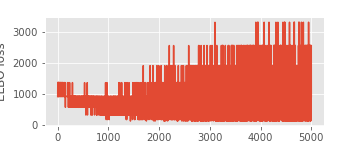Setup
Hi everyone,
I’ve been trying to build a model with a continuous latent variable that goes through a discrete deterministic step before being observed. In this case, the continous latent variable gets rounded to the nearest integer. Here is a simple toy model :
def model(n_data_points=1, data=None):
continuous = pyro.sample("continuous", dist.Uniform(0, 10))
discrete = pyro.deterministic("discrete", torch.round(continuous))
with pyro.plate("data_points", n_data_points):
return pyro.sample("observed", dist.Normal(loc=discrete, scale=1), obs=data)
Let’s say the true value of the latent variable is around 8. I generate 100 observed data points that match this assumption:
data = torch.randn((100,)) + 8
Using MCMC: works as expected
Using MCMC to sample the posterior gives the expected results:
pyro.clear_param_store()
from pyro.infer.mcmc.api import MCMC
from pyro.infer.mcmc import NUTS
pyro.set_rng_seed(2)
kernel = NUTS(model)
mcmc = MCMC(kernel, num_samples=100, warmup_steps=50)
mcmc.run(n_data_points=len(data), data=data)
mcmc.summary()
Output:
mean std median 5.0% 95.0% n_eff r_hat
continuous 8.06 0.30 8.07 7.56 8.43 67.28 0.99
Number of divergences: 31
So far, so good.
However, I noticed that the sampling was particularly slow compared to other models I have tried.
Using SVI: Does not converge
Here is my attempt at using SVI:
pyro.clear_param_store()
guide = pyro.infer.autoguide.AutoDiagonalNormal(model)
adam = pyro.optim.Adam({"lr": 0.001})
elbo = pyro.infer.Trace_ELBO(num_particles=1)
svi = pyro.infer.SVI(model, guide, adam, elbo)
for step in range(5000):
loss = svi.step(n_data_points=len(data), data=data)
The elbo loss does not go down but seems to move around randomly.

What I’ve tried
- Using AutoDelta to perform MAP estimation instead of AutoDiagonalNormal: behavior is similar.
- Increasing or decreasing the learning rate by powers of 10: behavior is similar, although with bigger learning rates, the loss even tends to increase over time.
- Increasing num_particles in ELBO loss to try to stabilize the loss: behavior stays the same.
- Using TraceGraph_ELBO instead of Trace_ELBO.
Is there a problem with how I wrote my model and inference routine? I’m new to Pyro so I could have missed something obvious here.